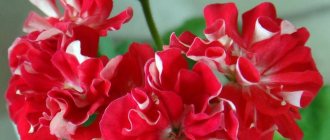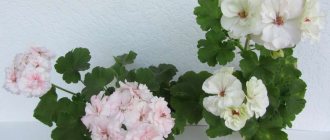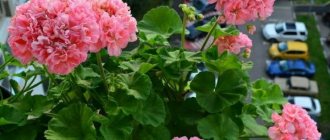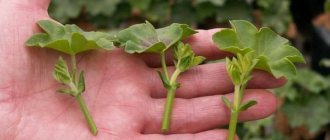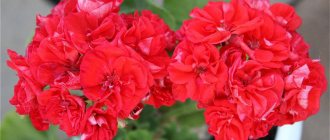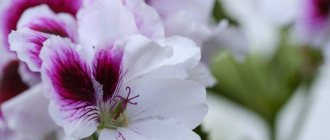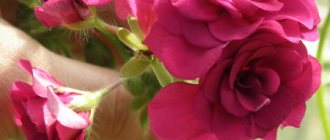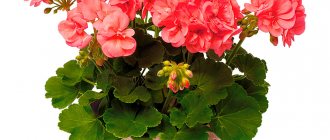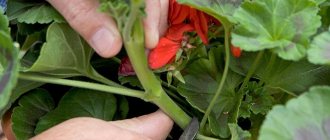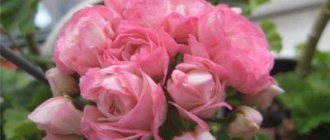For many decades, pelargoniums were considered a plant of aristocrats. Very wealthy owners of villas and mansions grew it in their greenhouses and gardens. In Russia, the period of popularity of this amazing flower gave way to an era of oblivion. Many will probably remember that there was a time when pelargonium was called nothing more than a bourgeois flower. However, years passed, and flower growers again remembered this luxurious flower, and therefore clubs for geranium lovers began to appear. Thanks to the efforts of breeders, more and more new shades and forms are appearing. The article below will talk about the flower YUG-Shukar - pelargonium, which includes several varieties. She was bred by Yu. Gonchar.
How to care for YUG variety plants at home
Like other pelargoniums, Yu. Gonchar varieties are unpretentious. However, in order for plants to fully display all their decorative potential, it is necessary to provide them with comfortable conditions.
Illumination and temperature conditions
This culture can be classified as light-loving. Experienced gardeners recommend placing pelargoniums on the south or east side. To ensure that each side of the bush receives enough light, you should rotate it from time to time.
Excessive watering can lead to the development of diseases such as blackleg and dropsy.
In spring and summer, it is necessary to maintain the air temperature at about 20-23 °C; during the rest period, it should be about 15-17 °C.
Watering rules and humidity
The humidity level suitable for pelargoniums is 60%. In this case, the plants do not need spraying. Watering should be moderate, moisture stagnation is unacceptable.
For your information! In spring and summer, flowers need only one watering per week; in winter, SOUTH pelargoniums should be watered no more than once a decade.
Fertilizing and soil quality
The soil should be nutritious and loose
It is important that the soil is breathable. You can purchase a universal mixture in a store or make it yourself by combining equal parts:
It is recommended to apply fertilizer only in the warm months, when plants develop and form flowers. Special mineral complexes are suitable for feeding.
Flower container size
It is better to choose a small container for pelargoniums of the group under consideration, otherwise the plant may stop flowering. Additionally, these flowers will hold their shape better in smaller containers or pots.
Pruning and replanting
Pelargoniums need sanitary pruning annually. It is best to carry out this procedure in March. Trimming must be done diagonally, using a sharp knife.
The best option for pelargoniums are clay pots with a drainage layer on the bottom.
Note! These plants do not like transplants, and therefore the container and soil for plants should not be changed more than once every couple of years.
Where and how to plant?
It is recommended to choose a pot for Pelargonium South that is not very large. Since its size directly affects the formation of a beautiful bush shape and the abundance of flowering. It is worth noting that in large flowerpots this plant practically does not bloom at all. It would be good if the planting container was made of clay.
When planting, do not forget about the drainage layer, the thickness of which should be at least 2 centimeters.
- Boarding order:
- Pelargonium Yug must be placed very carefully in a flowerpot, since the root system of this flower is very fragile.
- You just need to crush the earth, but under no circumstances compact it.
- Lightly pour settled water at room temperature on top.
Choosing a location and lighting .
There should be a lot of light, so it is recommended to place Pelargonium South on the south or east side of the room. An important element of care is regular ventilation so that the plant does not rot. If the flower does not have enough lighting, the leaves will begin to turn yellow, and the lower ones will completely fall off.In order for the correct bush to form, the plant must be periodically turned with different sides to the sun.
- Soil .
Pelargonium South requires a loose, nutritious substrate that easily allows water and air to pass through. Usually the soil is bought ready-made in the store. But you can cook it yourself. To do this, you need to take the following components in equal proportions: leaf and turf soil, peat, humus and coarse river sand. The acidity of the soil should be neutral.
How to properly care?
First of all, after purchasing a flower, you need to inspect it for withered leaves and insects hiding under them. For the flower you need to choose a well-lit, warm place without the scorching rays of the sun and drafts and, preferably, without other plants.
There is no need to replant flowering pelargonium immediately after purchase, even if the land in which it is now located seems scarce to you. Pelargonium does not like nutritious soil; it blooms poorly in such soil and does not tolerate excess water. Pelargonium loves fresh air, so in summer, when the weather is warm, it is good to keep it on the balcony, where there is the possibility of shading.
If the plant does not bloom, then its replanting will most likely be successful. Once removed from the ground, the root does not need to be washed. A little expanded clay or broken shards are poured into the bottom of the pot, then a layer of soil, then the plant is placed on the soil, sprinkled with earth, lightly compacted and watered.
Transplantation of yellow pelargonium is done in the spring. If a complete transplant is not possible, then the top layer of soil is replaced. The pot should be slightly wider than the root system.
In order for the bush to branch well, at the end of winter - beginning of spring you will have to pinch it, removing the growth zone. This will force the plant to throw out new side shoots, and a more luxuriant bush will form.
Yellow pelargonium should be watered sparingly; the flower tolerates drought more easily than waterlogged soil. You cannot spray zonal pelargonium - during the flowering period this can have a bad effect on the flowers. Mineral or liquid fertilizers are good as feeding for growing pelargonium, and during the flowering period - phosphorus-potassium fertilizers with a small nitrogen content. Fertilizing should be done weekly from May to September.
Note! Organic fertilizers cannot be used for pelargonium.
How a flower propagates: by seeds
This method is the longest and most labor-intensive, so in practice it is rarely used. In addition, when grown from seeds, varietal qualities deteriorate. Planting seeds is done in the spring. Planting material is purchased in advance at the store. A drainage layer of expanded clay is formed in the growing pots. Soil is poured into the container on top and watered.
Before planting, the seeds are soaked for 24 hours in a solution of a growth stimulator. After this, they are laid on the ground and lightly sprinkled with earth. The soil is sprayed from above and covered with film, putting it in a lighted place with a temperature of about 24 degrees. After eight to ten days, the first seedlings appear. After the third leaf, the seedlings are transplanted into separate pots.
general description
Pelargoniums are part of the Geranium family. It unites several hundred plant species. These are both subshrubs and herbaceous specimens. Only a few types of pelargonium are grown at home. But even so, the choice is very wide.
Flowers have a variety of colors. They form small or large inflorescences in the form of umbrellas. White, soft and bright pink, red, burgundy, purple and other expressive tones leave no one indifferent. The colors can be either monochromatic or combined. The leaves are simple but beautiful. They are usually green, but there are other options, including variegated ones. Plants are perennial.
Pelargoniums of the YUG series are the creations of the wonderful breeder Yulia Gonchar from the Voronezh region. Actually, the large letters in the names of the varieties actually mean the initials of the creator. All varieties bred by Julia bloom readily and profusely. The bushes are usually compact and fluffy. The exception is YUG-Shukar, which is of average height and requires shaping.
History of origin
Initially, India was considered the birthplace of pelargonium, but this statement was erroneous. And all because it was delivered on European ships that sailed to the shores of India. As it turns out, South Africa is the true place where pelargonium grows . There, at the Cape of Good Hope, sailors bought exotic plants for breeders and botanists. 80% of the known pelargonium species were found in this part of the world.
In 1951, an association of amateurs and breeders called the British Pelargonium and Geranium Society was created in England, under the leadership of John Cross. Thanks to this, a new wave of popularity for pelargoniums began, and interest in marvelous flowers was revived, which continues today.
Reference. More than 100 million plants are grown and sold worldwide each year.
Diseases and pests
When the soil is over-moistened, gray rot appears, which is easy to visually detect by characteristic spots. The affected parts are removed and the plant is treated with a fungicide.
When the air is dry, rust appears on the leaves of pelargonium. Treatment is the same as for gray rot. The disease can be identified by a characteristic brown coating on the leaves.
When there is a lack of air humidity, the plant is affected by spider mites. Its presence is determined by the characteristic web on geraniums. To kill the pest, the entire plant is sprayed with an insecticide.
Aphids are also easy to see visually. It attaches to the outside of the leaf and stems. Insects are carefully cleaned with a cotton swab, and the geranium is washed with soapy water and treated with an insecticide.
The description of a variety does not always give a complete picture of the characteristics of a particular pelargonium. Carefully study the care recommendations, this will help preserve the plant for many years.
Necessary conditions for landing
Let's find out what requirements Lady Gertrude places on her habitat: what soil composition is important for her, the level of light, temperature and other nuances.
Location and lighting
Since the petals of this pelargonium are very delicate, direct sunlight should not affect them. And although Lady Gertrude needs good lighting, the pot with the plant should be shaded at midday. Note that with constant exposure to active sunlight on the leaves and petals, the latter become paler, the bush itself becomes smaller, looks sick, and inconspicuous.
Note! In order for the plant to bloom magnificently and develop safely, it needs about 4-8 hours of bright light per day.
It is recommended to place the container with this flower on western or eastern windowsills. The southern side with active sun and the dark northern side are not suitable for the plant. In winter, it is recommended to provide additional lighting for Gertrude so that the inflorescences form more actively.
Temperature
For the summer period, the plant is suitable for keeping at a temperature of +20-25 degrees. In winter, pelargonium needs coolness: +12-15 degrees would be the best option. Note that the plant cannot withstand heat and when the temperature rises to +30, flowering stops.
If the heat lasts for a long time, the plant may completely wither
When flowering, it is also important to prevent the petals from touching cold glass and to rid the plant of drafts. Otherwise, pelargonium will begin to drop flowers
The soil
Pelargonium Lady Gertrude prefers to grow in loose, nutritious soil. It is necessary to avoid the presence of clay inclusions in the substrate, as they greatly weigh it down. Good drainage is important for the plant.
To ensure the outflow of water from the substrate to the bottom of the pot, be sure to place a layer of expanded clay pebbles or crushed bricks. The suitable substrate composition for this pelargonium is as follows:
- turf - 1 part;
- peat soil - 1 part;
- sand - 1 part.
In addition, the soil must have a neutral or slightly acidic reaction. Pelargonium will not grow in acidified soil.
The soil
For the pelargoniums of this group, loose, nutritious soil is suitable. In addition, it must be water- and breathable. A gardener can take the easy route and purchase soil mixture at the store. You can prepare the soil yourself. In this case, you should take in equal shares:
The acidity level should be neutral. The culture does not like transplantation. Therefore, the plant should be moved maximum once every 2–3 years.
Varieties
The YUG group currently includes many varieties. They have different colors, and this allows collectors to show interest in new species. The shades of some varieties of pelargonium change during flowering. For example, like YUG Varvara-Kras’s pelargonium.
Geranium variety with double-colored petals
- SOUTH Shukar - rich burgundy color of the petals, size about 50 cm, requires the formation of a crown.
- SOUTH Jadwiga pelargonium - flowers are soft pink, do not require pruning, green leaves. Average height 40 cm.
- SOUTH Sakura - the name comes from the plant of the same name. The center of the flower is crimson, the rest is light pink. The leaves are serrated.
- Pelargonium Varvara-Krasa is a dwarf size, height does not exceed 30 cm. Double flowers are similar in shape to peonies. Color white-pink. Blooms for a long time.
- SOUTH Zlatoslava - Bright pink inflorescences. The leaves are green with a slight tint of gold.
- SOUTH Claudia - snow-white, double flowers, plant size is dwarf, crown formation is not required.
- SOUTH Princess Grace is an original variety. The white petals are edged with a dark pink border.
- Pelargonium SOUTH Ireland - flowers are white, sometimes greenish in the middle and outside of the petals. Does not require the formation of a bush.
- SOUTH Yesenia - pink flowers with reddish veins, the edges of the petals are pinkish-white.
- SOUTH Nina - golden foliage. The flowers are densely double, pale lilac-pink. The bush forms independently.
Pelargonium SOUTH Shukar needs the right conditions. The abundance of flowering and the lifespan of the flower depend on this.
Important! If you deviate from the recommendations, the geranium may stop blooming. Factors required to grow a flower:
Factors required to grow a flower:
- Illumination is diffused light; during the flowering period, the duration of daylight is at least 8 hours.
- Temperature – in the warm season – 23 °C, in the winter – 15 °C.
- Watering – during the flowering period, the plant is watered once a week, as stagnation of moisture leads to the development of gray rot. In winter, the amount of watering is reduced to once every 10 days. The humidity level is maintained at 60%. SOUTH Segal pelargonium and others do not need spraying.
- Fertilizing – during flowering, add a universal remedy for flowering plants once a week. The soil should be loose and nutritious.
- The size of the pot is 1 cm larger than the earthen ball.
- Pruning - dwarf varieties do not need to form stems; taller specimens can be pinched out in the spring. Transplantation is carried out once a year.
Features of periods of development
The plant has two periods of time in the year - dormancy and active growth. They must be changed periodically, otherwise the geranium will not live long.
Periods
Epipremnum aureus - home care and other varieties
Growth time is in spring and summer. Around mid-April, pelargonium awakens from hibernation and begins to grow. At this time, bud formation and flowering occur.
This is interesting! Some varieties of geraniums bloom for a very long time (even in winter), for example, YUG Kamalia pelargonium.
In spring, geraniums form buds
Preparation for dormancy begins around September. During this period, the plant is not replanted, fed or rearranged. It is advisable to reduce the temperature, the amount of watering and the length of daylight hours.
Geraniums awaken gradually. To do this, they are gradually returned to their usual conditions of detention, imitating the change of seasons in nature.
Types of flowers
The varieties differ not only in size and color. Pelargonium SOUTH Deya, for example, has double petals - this makes the flowers voluminous, lush, and beautiful. They are called terry.
Varieties may have different flower shapes. For example, in tulip pelargonium they resemble tulips. This also applies to rosebud species. Deacons look especially beautiful. This geranium has flowers collected in a small bouquet.
Description of appearance and features
Terry pelargoniums have a large number of petals, collected in umbrella-shaped inflorescences that resemble rounded caps. The underside of the petals is lighter, making the flowers look fluffy.
The plants have a straight and strong stem covered with lush foliage. The leaves are slightly velvety to the touch. The inflorescences are represented by a variety of colors and shade palette: white, pink, purple, etc.
Pelargoniums have a tart odor from the leaves, which causes headaches for some people (therefore, the plant is not suitable for everyone). This smell repels insects such as flies and moths. For other people, on the contrary, the pronounced aroma of the flower has a calming effect, relieves headaches and insomnia, and also has a beneficial effect on cardiovascular diseases and hypertension.
The plant is light-loving, easily tolerates drought and is quite unpretentious in maintenance.
Diseases and harmful insects
Pelargonium is resistant to various diseases and pests. But they still occur:
- Gray mold is a disease that affects leaves. You need to fight it in the following way: remove damaged leaves, stop watering the plant, put it in the sun, spray it with an antifungal agent.
- Rot of the root collar of a flower develops with excess moisture. This phenomenon turns out to be detrimental to pelargonium.
- Rust appears as yellow spots on the bottom of the leaf.
Disease prevention is to treat plants with antifungal solutions before wintering. They are also sprayed with fungicide products, the drug “Doctor Foley” for fungi. The affected parts of the plant must be removed. Among insects, the main pests are whiteflies, aphids, mites, thrips, and mealybugs.
Growing pelargonium at home is not at all difficult. Especially if you follow the basic rules for caring for the plant. Then the flower will grow and smell fragrant for joy.
If you find an error, please select a piece of text and press Ctrl+Enter.
Pelargoniums have won the love of many gardeners. Luxurious decorative flowers with a delicate aroma transform any room. Thanks to the efforts of breeders, the range of crop varieties is constantly expanding. The variety of shades and shapes makes it possible for everyone to find a plant to their liking. One of the popular groups is the South Pelargonium. Let's consider the characteristics and features of growing these flowers.
General rules of care
Caring for pelargonium is very simple. Even a beginner in floriculture can handle it. Here are a few key points to know:
- Pelargonium prefers well-lit places.
- Propagated by cuttings and seeds.
- Most varieties require additional bush formation. Pinch out plants at the end of winter.
- In spring and summer, watering is plentiful, but with the onset of the winter season, watering is reduced.
- For lush flowering, regular feeding is carried out. Fertilizers containing phosphorus stimulate the formation of buds.
Also on our website we have prepared for you a number of articles with descriptions and recommendations for growing and caring for the following varieties of pelargonium: Australian Rosebud, Silk, Angel, Pak, Viva, Rococo, Stellar, South, April Snow, Lady Gertrude.
Growing problems and pests
The main pests of pelargonium are the root bug, which spoils the roots of the plant, and the whitefly, which likes to settle on the inside of the leaves. The appearance of root worms is promoted by excessive soil moisture. Insecticides are used to combat it. But in the case of damage to the root system, it is better to say goodbye to the flower and replant the cut off tops of the plant in new soil.
If you create suitable conditions for a perennial flower, it will delight you with its unique color for a long time. The main thing is not to overdo it with watering.
Reproduction methods
Cuttings
- At the end of flowering, the tops of the pelargonium are cut off. The top 3 leaves are left, the others are removed.
- Sections must be treated with fungicide, ash or activated carbon. This is done so that the stem of the mother plant does not rot.
- Then the cuttings are placed in transparent glasses with drainage, coke fiber or coarse sand is placed in them, and liquid is poured in.
Another option is to place the cuttings in a container with water and, as they dry, it needs to be added.
Roots appear quite quickly, after 10-12 days. The temperature in the room must be maintained at least +20°C. After this, the rooted cuttings are planted in previously prepared soil in a permanent place, where they continue to develop.
Next, you can watch a video that talks about cuttings:
Dividing the bush
If the bush has grown, you can divide it. The best time for this is spring, when the plant is replanted and the soil is renewed.
- First of all, remove the flower from the pot and shake off excess soil.
- Then they carefully examine his kidneys.
- The area with healthy kidneys is separated and transplanted into another container.
Varieties: description and photo
We will describe the most popular varieties - Shukar, Varvara Krasa, Nina, Kamalia.
Nina
The species belongs to the zonal genus and is a dwarf variety. The buds have very dense petals that are slightly terry. Their shade is soft pink with a purple tint. The shrub turns out to be very lush, but at the same time, due to dwarfism, it turns out to be compact. Due to their splendor, the inflorescences resemble rosebuds.
The shoots and peduncles are dense, fleshy, and grow straight up. The leaf blades are pale green, even slightly with a golden tint, and have brown edges.
Reference! Julia Gonchar gave the name to the variety in honor of her grandmother.
A cutting of this variety will cost approximately 1000-1500 rubles.
Shukar
This is another representative of a zonal species. The size of the bush is standard, but requires regular pruning to form a beautiful shape. Inflorescences are scattered on different sides. The petals take on all shades of red: from scarlet to rich cherry. Flowers are found both simple and double. It all depends on care. The petals are slightly oblong in shape.
The name “Shukar” is translated from Greek as “beauty”.
Reference! You can buy a young Shukar for about 1000-1200 rubles.
Varvara Krasa
Also a zonal plant that grows exclusively upright. This variety is a dwarf variety (read about how to properly care for dwarf pelargonium here). The bush grows very thick, dense, does not require pruning - the correct shape is created as it grows.
The buds are large relative to the leaves and the size of the entire plant as a whole. The petals are terry to the touch and pale pink in color. But in good lighting they take on a more saturated hue. This variety blooms profusely and for a long time.
Kamalia
Again a representative of dwarfs. The bush is very lush, the leaf plates are of a standard green color. The inflorescences have an unusual shape; from a distance they seem slightly shabby. The shade of the petals varies from soft pink to rich.
The main characteristic of Kamalia is its long flowering, even in the cold season. The texture of the buds is terry.
Reference! The price of one cutting ranges from 500-700 rubles.
Varieties of indoor plants with names
Pelargonium PAC Viva Madeleine, Carolina and other varieties
This group of pelargoniums includes several varieties. They all differ from each other in the shape of flowers and leaves, color. The most popular varieties bred by Yu. Gonchar are described below.
SOUTH-Shukar
This spectacular variety belongs to the group of zonal pelargoniums. The flowers are ordinary or double, which have a cherry-scarlet hue. The plant needs regular pruning, otherwise it will lose its decorative shape. Pelargonium foliage is rich green.
SOUTH-Jadwiga
Pelargonium South-Jadwiga is a strong compact bush, literally strewn with bright pink flowers. The plant does not require formation; in itself it is quite neat. Jadwiga leaves are ordinary green.
SOUTH-Varvara beauty
YUG-Varvara Krasa is a pelargonium, which is called one of the most compact among those bred by Yu. Gonchar. The bush has the correct shape, it is neat and dense. It doesn't require formation. Terry buds of a delicate pink shade are more like miniature roses or peonies rather than geraniums.
The lush inflorescences of this pelargonium resemble tiny bridal bouquets
Note! If Pelargonium Varvara Krasna has enough sunny color, the color of its petals becomes brighter.
SOUTH-Sakura
It’s easy to guess that this variety got its name due to its amazing similarity to Japanese cherries. The flowers are characterized by a light pink tint, with bright crimson rays radiating from the center of each flower to the edges. The leaves are quite dense with small teeth along the edges.
SOUTH-Zlatoslava
Dwarf pelargonium Zlatoslav differs from other varieties of Yu. Gonchar in its original golden tint of foliage. The flowers are wavy and purple-pink in color.
SOUTH-Claudia
Pelargonium of this variety is called one of the most delicate. A small compact bush with rich green leaves is decorated with lush caps of white and pink buds.
Important! The plant does not need pruning.
SOUTH-Princess Grace
It is no coincidence that this flower received its royal name. Princess Gray - the true embodiment of tenderness - will take its rightful place in the collection of any gardener. A neat rose bush has rough leaves of a pleasant green hue and fairly large buds of a soft pink shade with iridescence.
YUG-Nina and others
Depending on the time of year, the color of the petals of the YUG-Deya variety changes: in summer it is salmon-pink, in spring it is white with a subtle pink blush, and in autumn it is pale pink.
Another incredibly delicate pelargonium is YUG-Nina. Golden foliage with a refined brown edge is combined with dense flowers, which are characterized by a pale pink hue and a subtle purple tone.
For your information! Pelargonium YUG-Nina was named after Grandmother Gonchar.
Pelargonium South-Kamalia belongs to the dwarf group. The variety is characterized by long flowering, lush double flowers of a pink hue. The inflorescences seem to be disheveled; they look really unusual.
White-pink pelargonium YUG-Sigal, according to gardeners, with proper care, has densely double flowers, reminiscent of mini-heads of ornamental cabbage. In direct sunlight, the flowers take on a rich pink tone.
Bright reddish-crimson tone with a white glow, long peduncles - this is the South-Aksinya pelargonium. Delicate pink color and original two-color leaves - this is the beauty of YUG-Bibigul. Pelargonium SOUTH-Ireland is a fluffy bush with snow-white inflorescences. And the pink center and white edges are a variety called YUG-Yesenia.
The pelargonium of YUG-Deya deserves special attention
In addition, today such varieties as YUG-Polina, YUG-Giselle, YUG-Tamila, YUG-Michel, YUG-Sibir, etc. are known.
Description of pelargonium varieties of the Elnaryds series
Nothing is known about the origins of Elnaryds. However, the description of popular geranium varieties from this series is worth studying in order to choose the most suitable one for yourself.
Pelargonium Elnarids Hilda
Hilda
Pelargonium Elnaryds Hilda is a dwarf variety. The petals are white in the center, turning salmon color towards the edges. Double flowers.
Gusten
Pelargonium Elnaryds Gusten is distinguished by double inflorescences. The flowers are light peach in color. The bush is compact.
Bente
The Bente hybrid grows up to 10-12 cm in height. The inflorescences are double, the shade of the petals is soft apricot turning into a rich red color.
Lilian
The Lilian variety is characterized by lush inflorescences collected from double flowers. Petals are pale pink.
Clarissa
The Clarissa variety is distinguished by double and semi-double flowers collected in spherical inflorescences. Petals are white.
Variety Elnardis Clarissa
Hybrids with white flowers
White color is often found in the case of double pelargoniums. Such plants look like air clouds above green bushes. Densely double (from 8 petals) and double (6-8 petals) varieties are represented by many varieties. Even tulip-shaped geraniums can have lush flowers. Let me try to list the main hybrids that I came across while growing a group or just from friends, and I’ll show them in the photo.
Glacis is an incredibly compact variety with long stems. Lush white inflorescences with double flowers are located high above dark green foliage with a clearly defined zonal pattern.
Kronprinsesse Mary is a very young variety, obtained in 2012. At the moment it is a little-known and very rare domestic specimen.
Nan West is a white variety with pink spots on the corolla petals. Belongs to the subgroup of bird's egg pelargoniums. The plant develops a robust bush with strong stems.
Conditions for growing indoor flowers
Pelargonium is an undemanding indoor flower. However, for a healthy and beautiful appearance, comfortable conditions are important for the plant.
An indoor flower should be watered abundantly, but at the same time the water should not stagnate in the pot. Watering is needed abundantly, daily, especially in hot weather. In winter, you don’t need to water much, but you should not let the soil dry out completely. If watering is abundant, traces of gray rot appear on the leaves, and sometimes the stem rots, which can lead to the loss of the plant. If you water little, the flower withers, the leaves begin to turn yellow and dry out. Air humidity is not particularly important for pelargonium; on the contrary, excess moisture and stagnant air can cause fungal diseases of the flower. Spraying should not be done. In the warm season, the optimal temperature is +18 -22 C°. Sufficiently high air temperatures, especially indoors, will also negatively affect the plant. In winter, pelargonium is in a state of sleep. Plants should be moved to a room with a temperature of +12°C and regular ventilation. This could be a loggia, balcony, greenhouse. Watering should be sparse. Wintering lasts approximately from November to February. At the end of winter, pelargonium begins to gradually wake up. Replanting and pruning. These procedures should be performed annually, preferably in the spring, in mid-March. In order for the plant to have a lush appearance, it is necessary to trim the pieces. Perform this procedure only with a sharp knife diagonally. Broken parts of the plant may be affected by rot. And to enhance growth and branching, shoots are pinched. To ensure adequate nutrition, the flower needs to be fed and organic fertilizers applied.
But it is important to dose the fertilizer and follow all the instructions indicated on the package: Feed “Mr. Color” Saintpaulia during or before flowering with 1 capful per 1 liter of water. "Gilea" - recommended concentration is 2 caps per 1 liter. “Fertimix” vermicompost for flowering plants, 3 caps per 1 liter, apply once every 10-14 days.
Adding nutrients is prohibited in hot weather. In this case, the plant will suffer stress.
- First, you should move it to a cool place.
- Next, be sure to water the flower, otherwise fertilizers may burn the roots.
Most of all, the plant needs additional nutrition in summer and spring. Therefore, you need to feed until the beginning of September, approximately once every 2 weeks. You should not feed a transplanted or just purchased plant; you need to wait at least 1 month. It is also not recommended to use mineral fertilizers for sick flowers with damaged root systems.
Features of plant flowering
Pelargonium Tuscany and its varieties Edwards, Bernd and others
Features of plant care and its appearance differ depending on the period of time.
Period of activity and rest
During the winter months, South Pelargoniums are dormant. At this time, it is recommended to move the containers with them to a cool, frequently ventilated room and reduce watering. The plant should be in this state from November to February. In spring, a period of active growth begins. The plant requires a lot of strength, and therefore it is important to fertilize and moisten it in a timely manner.
Types and shape of flowers
Yu. Gonchar pelargonium flowers differ in color and shape. The color can be white, rich red, delicate or bright pink. As for the forms, there are such pelargoniums as:
- simple. Their petals are arranged in one row;
- semi-double. Each flower has two or three rows of petals;
- terry. Pelargoniums are characterized by the presence of several rows of petals.
